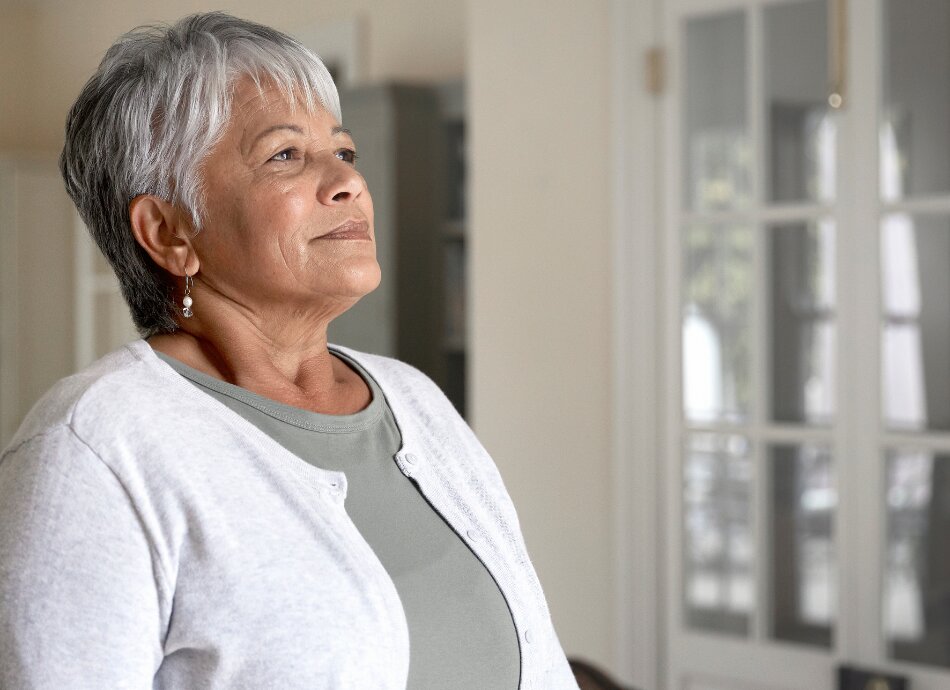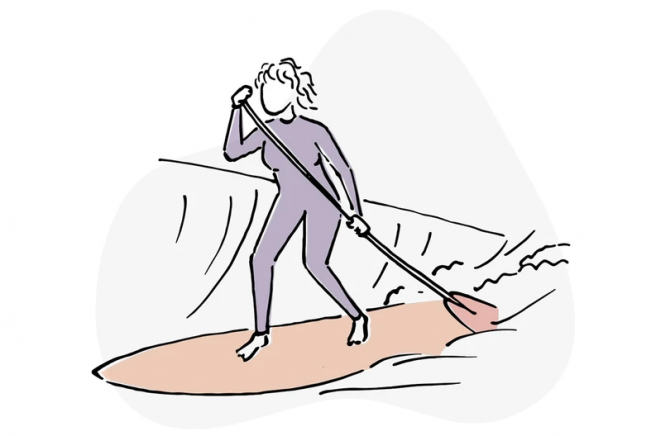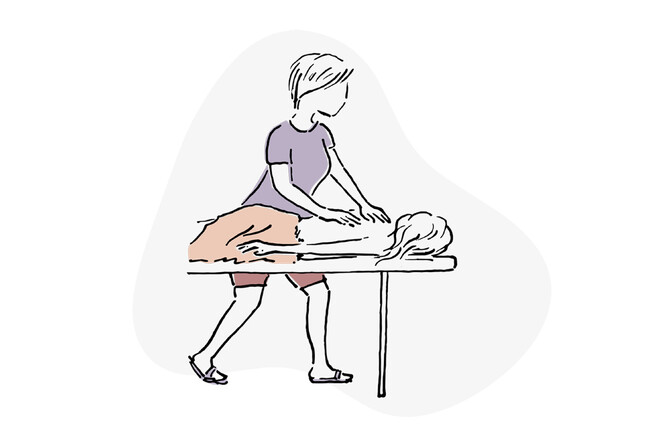Pelvic organ prolapse
Key points about pelvic organ prolapse
- Vaginal prolapse or genitourinary prolapse is a condition in women where the organs in your pelvis (uterus, bladder and rectum) slip down from their usual position into your vagina.
- This is different from a rectal/bowel prolapse where the point of weakness starts in the bowel/rectum not your vagina.
- Mild pelvic organ prolapse often causes no symptoms and treatment is not always needed.
- But sometimes a prolapse may be concerning enough to need treatment from a health professional.
- If you are worried please see your healthcare provider.

The pelvic organs are held in place by ligaments and pelvic floor muscles. If the ligaments are torn or stretched for any reason, and if your pelvic floor muscles are weak, then your pelvic organs might not be held in their right place and they may bulge or sag down into your vagina.

Image credit: Canva
Pelvic organ prolapse is caused by either a weakness in the supports of the pelvis or by an increase in the pressure inside the abdominal cavity.
The most common causes of weakness of the supports are:
- pregnancy and childbirth
- ageing and menopause
- hysterectomy
- a genetic tendency.
The most common causes of an increase in abdominal pressure are:
- being overweight
- constipation
- excessive coughing
- excessive exercise or heavy lifting.
Often it is a combination of these factors that result in you having a prolapse.
Being pregnant and giving birth
This is the most common cause of weakening of the pelvic floor support muscles, especially if your baby was large, you had an assisted birth (forceps/ventouse) or your labour was very long.
The more births a woman has, the more likely she is to develop a prolapse in later life; however, you can still get a prolapse even if you haven’t given birth.
Performing pelvic floor exercises is very important after childbirth but may not prevent prolapse from occurring and will not restore a large prolapse.
Ageing and menopause
Prolapse is more common as women get older, particularly after menopause.
A decrease in the female hormone oestrogen, that occurs after the menopause, affects the pelvic floor muscles and structures around the vagina. This makes them less springy and supportive.
The word ‘prolapse’ means a falling down or slipping of a body part from its usual position. There are different types of prolapse depending on which pelvic organ might have dropped down into the vagina.
- Cystocele – this is where there is prolapse of the bladder into the vagina. This is the most common type of prolapse.
- Uterine prolapse – this is the second most common type and is the name if there is prolapse of the womb (uterus) into the vagina.
- Rectocele – name used if the prolapse involves the rectum (the back passage or bottom).
- Enterocele (small bowel prolapse) – occurs when the small bowel presses against and moves the upper wall of the vagina.
- Vault prolapse – where the top of the vagina comes down after the uterus has been removed via hysterectomy.
There are a number of signs that you may have a prolapse. These signs depend on the type of prolapse and how much pelvic organ support has been weakened or lost.
If the prolapse is mild, you may not know you have a prolapse as there will be no symptoms, but your doctor or nurse might be able to see your prolapse when you have your routine cervical smear test. Not all woman undergo regular smear tests, for example if your cervix has been removed, so it is important to recognise these symptoms.
When a prolapse is larger, you may notice things such as:
- a heavy sensation or dragging in the vagina
- something ‘coming down’ or a lump in the vagina
- a lump bulging out of your vagina, which you see or feel when you are in the shower or having a bath
- pain during sex
- loss of sensation during sex
- your bladder might not empty as it should or your urine stream might be weak
- recurring urinary tract infections
- it might be hard for you to empty your bowel.
These signs can be worse at the end of the day and may feel better after lying down. If the prolapse bulges right outside your body, you may feel sore and bleed as the prolapse rubs on your underwear.
To diagnose a prolapse your doctor will need to perform a vaginal examination. You can choose if this happens on your initial visit. Some people may find this stressful especially for those who previously have had a traumatising experience, particularly a sexual assault. It can be helpful for your doctor to know if this is the case.
The examination will be done in a private and respectful way and you are welcome to bring a support person. A speculum, a plastic or metal instrument, may be inserted. This is used to separate the walls of the vagina so your doctor can see into your vaginal cavity to diagnose exactly which organ(s) are prolapsing.
You may be told you have a mild prolapse with little or no symptoms, meaning no treatment is needed at this stage. However, some degree of prolapse is quite common and if it doesn't trouble you there's no need to get it regularly checked. There are many self-care tips that you can follow to help prevent further prolapse, ease any symptoms you may have, or prevent the prolapse from becoming bothersome.
Things you can do to improve your symptoms
- If you are overweight losing weight can help.
- Managing a chronic cough if you have one.
- Getting support to quit smoking.
- Avoid constipation and straining when passing poos. Talk to your doctor about ways of helping and treating constipation.
- Avoid heavy lifting. You may wish to talk to your employer if your job involves heavy lifting.
- Avoid high-impact or excessive physical activity.
- Pelvic floor exercises may help to strengthen your pelvic floor muscles.
- Your doctor can put you in touch with a pelvic physiotherapist or you can find one here.(external link)
- Vaginal hormone treatment (oestrogen) – if you have a mild prolapse and you have gone through menopause, your doctor may recommend applying oestrogen cream to your vagina for 4–6 weeks. This may help any feelings of discomfort that you may have. However, sometimes symptoms return once the cream is stopped.
If your symptoms are more severe, your doctor will discuss the following treatment options with you:
- Ring pessary – having a pessary (a plastic or rubber device that fits into your vagina) carefully measured and placed into the vagina to provide inside support for your pelvic organs. This is called a ring pessary. Read more about ring pessaries.
- Surgery – an operation can be done to repair the torn or stretched ligaments. This can be done through the vagina or the tummy. Sometimes special mesh is used to strengthen it where it is weak or torn, but this is not the only or preferred option as there are mesh free alternatives available, like native tissue repair. Your doctor can talk you through the pros and cons of having mesh or non-mesh surgery. It's best to wait until you have completed your family before having surgery. Read more about surgical mesh.
Apps reviewed by Healthify
You may find it useful to look at some Pelvic floor exercise apps.
POP goes my pelvis and the POP project
POP at 54, story at 55

 I love the outdoors. I’m a keen tramper. I enjoy stand up paddleboarding (SUP) and surfing, kiteboarding, sailing. I run bush skills courses for women. I can spend hours working in the garden. I feel fit and active.
I love the outdoors. I’m a keen tramper. I enjoy stand up paddleboarding (SUP) and surfing, kiteboarding, sailing. I run bush skills courses for women. I can spend hours working in the garden. I feel fit and active.
POP!? Why me?
In July 2019, my peeing felt a little bit different for a couple of days. The following night I had to get up to the loo nearly every hour, each time feeling more uncomfortable ‘down there’. Explaining it to my husband the next morning, I said “it feels like something is going to fall out of my vagina”. No other way to describe it.
After googling my symptoms, ‘bladder prolapse’ appeared on the screen. It sounded vaguely familiar, but I certainly couldn’t relate it to me. Luckily I managed to get the last appointment at the medical centre (it was Friday of all days!). The doctor’s examination confirmed a prolapse – not bladder but uterus. I felt stunned.
Read more of this story(external link).
Keeping active for physical and mental health
POP at 35, story at 38

I was 35 years old and three weeks postpartum after my first baby when (after lots of googling with few answers) I went to a GP thinking I had a prolapse. This was because I had looked at my bits with a mirror and didn’t think they looked right! Even considering that I’d not long pushed a baby out, I still thought it didn’t look or feel right. I could see ridgy bumps and other soft pink bulges coming out that I had NEVER seen before. The GP said I didn’t have a prolapse. She did tell me how she had a prolapse from giving birth though! I was a bit miffed but that was that.
During labour my midwife had said that my pelvic floor was ‘too good’ and was hindering my pushing efforts. I’ve worked out since that you need to learn to relax those muscles to push a baby out! I’ve also heard you can really damage your pelvic floor even if it was really good to begin with. Who knew?!
Read more of this story(external link).
My journey with POP
POP at 40, story at 50

I am 50 years old with three children.
I have had issues with a weak pelvic floor for years. When my kids were tiny, I did a few Kegel exercises, but never progressed on from that. When my youngest daughter was about 2 years old, we went camping and I joined in a softball game. The running caused great leaking and I ended up with soaked trousers. I still thought it was just my pelvic floor and still didn't get it checked out properly.
A few years later, I had mycoplasma pneumonia and coughed like crazy for three weeks, needing to wear a panty liner constantly as I was leaking so much. I still didn't think much of it...! Well, I realised it was bad, but I was still thinking ‘weak pelvic floor’.
Read more of this story(external link).
Navigating the shame and empowerment
POP at 28, story at 34

I am a 34-year-old kiwi physiotherapist, and have always been active with netball, mountain biking, whitewater kayaking, and adventure racing. I have three children who were born when I was 26, 28 and 33. They were all fairly good sizes and my deliveries were natural, with no complications, and extremely fast (just a few minutes of pushing). After my first baby I started walking immediately and started some occasional running and social basketball from when she was about 8 weeks old, with no problems.
After my second baby, I became aware that things didn’t feel right when he was a few days old – a walk to the end of the driveway made me feel heavy in my pelvic area and I realised I had a prolapse. I saw my GP who wasn’t particularly helpful, and worked hard at pelvic floor strengthening which I designed using my physiotherapy knowledge. After about eight months I did return to everything that I enjoy including netball and long runs (3–4 hours). I found it hard to tell anyone that I had a prolapse – as if being fit, active and a physiotherapist should have protected me, and I felt embarrassed even though I knew how common it was.
Read more of this story(external link).
Read more personal stories of people living with pelvic organ prolapse(external link).
The following links provide further information on pelvic organ prolapse. Be aware that websites from other countries may contain information that differs from New Zealand recommendations.
Pelvic organ prolapse(external link) Continence NZ
Pelvic organ prolapse(external link) RANZCOG, NZ
Pelvic organ prolapse(external link) Patient Info, UK
Surgical mesh implants(external link) Medsafe, NZ
Apps
Clinical resources
Links for medical professionals(external link) Continence NZ
Continuing professional development
Video: Goodfellow Unit Webinar: Beyond mesh - I have a mesh, should I be worried, with Eva Fong
This video may take a few moments to load.
(Goodfellow Unit Webinar, NZ, 2020)
Apps
Credits: Healthify editorial team. Healthify is brought to you by Health Navigator Charitable Trust.
Reviewed by: ACC Treatment Safety team
Last reviewed:
Page last updated:





